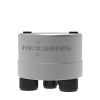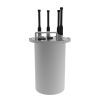Sequoia LISST-Tau Transmissometer
Features
- Measures optical transmission and beam attenuation
- RS-232 and analog real-time outputs
- Integrated temperature compensation & ambient light rejection
- Expedited repair and warranty service
- Lifetime technical support
- More
Overview
LISST-Tau is a high-precision transmissometer for underwater vehicles, profiling packages, CTDs, and other systems. With high-quality optics and a carefully selected LED source, it transmits a collimated beam through the water, and precisely measures the light transmitted through its 15 cm path. Light modulation with synchronous detection rejects ambient light, while oversampling and averaging yield better than 16-bit resolution. LISST-Tau’s digital controller applies calibration coefficients, corrects for temperature effects, and transmits data from both digital and analog outputs. Included software provides real-time display of data, and functions for checking and updating pure-water calibrations. An optional flow-through chamber simplifies calibrations and experiments. LISST-Tau advances the state of the art for in-situ transmissometers.
Remote Monitoring
The LISST-Tau transmissometer offers a plug-and-play interface to the NexSens X3 data loggers and telemetry systems. The X3 is available for pole-mount/buoy-based deployments with solar charging or connected to the X3-SUB submersible data logger with alkaline battery pack for subsurface deployments.
Parameters Measured
- Optical transmission
- Beam attenuation
Operating Ranges and Stability
- Operational temperature range: -3 °C to 40 °C
- Storage temperature range: -20 °C to 60 °C
- Beam attenuation range: ~0 m-1 to 30 m-1
- Linearity (concentration): >99 %
- Short-term stability (typical standard deviation over 1 minute)
- Transmission: 0.003 %FS (Green) / 0.005% (Red)
- Beam attenuation: 0.0002 m-1 (Green) / 0.0004 m-1 (Red)
- Long-term stability (6 hr test)
- Transmission: ~0.003 %FS/hr
- Beam attenuation: ~0.0002 m-1∙hr-1
Technology
- Optical path length: 15 cm
- Source wavelength: ~532 nm (Green) or ~650 nm (Red) LED
- Source spectral bandwidth: <10 nm FWHM
- Acceptance angle (half angle, in water): 1.0 °
- Optical transmission @ 16-bit resolution
Mechanical and Electrical
- Dimensions [Ø x L]: 5.1 cm x 40.6 cm (2.00″ x 16″)
- Weight [air / seawater]: 1.140 kg / 0.585 kg (2.5 lbs / 1.3 lbs)
- Depth rating: 2,000 m
- Sampling rate: 1 Hz
- External power input: 7 VDC to 25 VDC
- Current drain @ 12V: 42 mA average during sampling
- Connector: SubConn MCBH6M
- LISST-Tau transmissometer
- LISST-Tau 2-meter integrated communication and external power USB cable
- Windows software for real-time display of data, and functions for checking and updating pure-water calibrations
- Shipping case
In The News
Monitoring OAE Efforts in Halifax: Fighting Climate Change with Emerging mCDR Strategies
Marine carbon dioxide (CO 2 ) removal (mCDR) is an emerging strategy that aims to fight climate change by taking advantage of the carbon capture potential of our oceans. There are multiple types of mCDR approaches being evaluated globally, one of which is ocean alkalinity enhancement (OAE). According to NOAA , OAE aims to increase the pH of water by either adding alkaline material to ocean surface waters or by removing acid from seawater. Due to the change in acidity, the chemistry of seawater changes, making it capable of absorbing greater volumes of CO 2 .
Read MoreSource Water Monitoring in Albany, New York: Tracing Water Quality throughout Tributaries
Thousands of US cities pull their drinking water from natural source waters like reservoirs, rivers, and streams, making overall watershed health a key consideration for water providers. In Albany, New York, the Albany Department of Water and Water Supply delivers drinking water to over 100,000 residents as well as monitors and manages the larger drinking water supply watershed. Hannah Doherty, Environmental Specialist at the Albany Department of Water and Water Supply , spends her days working with a small team to monitor the drinking supply and the connected water bodies. Doherty explains, “We’re the first to encounter the water that ends up being the drinking water.
Read MoreWildfire Prevention in the Sierra Nevada Region with the Yuba Watershed Institute
Though recent wildfires have sparked new conversations about wildfire management and response, groups like the Yuba Watershed Institute have been monitoring the forests and water resources of the Sierra Nevada region for decades, managing approximately 5,000 acres of land with the Bureau of Land Management (BLM) and about 7,000 acres in private land partnerships. The goal of the Institute is to work with local communities and land agencies to improve watershed and forestry management through informed practices and public outreach. The goals of the Yuba Watershed Institute are three-fold: Improve the ability of fire suppression agencies like the California Department of Forestry and Fire Protection ( CAL FIRE ) and the US Forest Service.
Read More

















